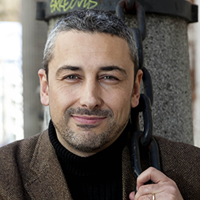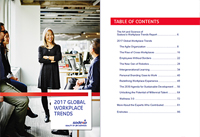A continuous learning model
Interview with Mariano Sánchez Martínez, Professor, University of Granada.
 Sodexo 2017 Global Workplace Trends Report is hot off the press with ten major trends that will impact our workplace today and in the years to come. Today we sat down with Mariano Sánchez Martínez, Professor at Universidad de Granada, Spain, to talk about a new approach to generations in the workplace.
Sodexo 2017 Global Workplace Trends Report is hot off the press with ten major trends that will impact our workplace today and in the years to come. Today we sat down with Mariano Sánchez Martínez, Professor at Universidad de Granada, Spain, to talk about a new approach to generations in the workplace.
From a sociology point of view, how is longer life expectancy changing the workplace and our lives in general?
Mariano Sánchez Martínez: As our life expectancy lengthens, the question arises: how should we re-think the life-course? If we live longer, we need to consider how we are going to change our approach to life. For starters, we must accept the challenge of living ever more uncertain lives as the pace of change – much of it technology-led - accelerates. Today, it is not unusual in Spain to come across the situation of someone in their 60s who is already retired but decides to go back to work to support their children and grandchildren. This is not evident as many still come from a generation whose grandparents used to think that everything was and had to be planned well in advance. Uncertainty of this type – that has impacts on the life-course, the role and responsibilities of generations – is now also a consideration for business.
How does this evolving landscape affect employee learning in the workplace?
M.S.M.: Firstly, it is time to banish the old idea that ‘intergeneration’ just has to do with old people working with young people. Generations have little to do with chronological age but rather the passing of time, trajectory, skills and experience.
Secondly, intergenerational learning can’t be linked to the idea of, for example, one person from Gen X being linked to one person from Gen Y; we all have multiple generational identities. For instance, I am an experienced father so I belong to that identity group. However, I also recently started to learn how to play the piano, so I am a beginner in the musical identity group. I have multiple generational identities within me. The traditional bilateral and linear way of thinking is over-simplistic; we need a much more complex and dynamic approach to intergenerational learning. So far, we have mentoring and reverse mentoring, only two ways; the issue at hand is much more complex than that.
What does it look like when a business gets it right?
M.S.M.: The closest example that I can think of is an intergenerational shared site that provides care for older adults and children. They tend to use a single approach in terms of how many generations are being gathered and in terms of intergenerational learning. I see a clear erosion of age in deciding what to do as well as an emerging generational intelligence. True generational intelligence is the capacity to be aware of generational positions and approach workforce management with a generational lens. That doesn’t mean organizing activities for different generations but rather activities that link generations and make them work together taking advantage of both their similarities and differences.
For instance, I would challenge anyone to think of a workplace for adults and older adults where children had the possibility to be included, in an organized way. Now is the time to innovate in this field. If we don’t do it now, we’ll see in a few years how the power and novelty of this idea may be wasted. Let’s promote business where all generations can be purposefully involved.
Do any concrete examples come to mind?
M.S.M.: In Spain, we are piloting an intergenerational school, a lifelong learning place for all ages. The idea is to cross the adult need to keep learning throughout the life-course with children’s educational needs. This is how we should also think of the workplace: a lifelong learning place where people from all generations are invited and engaged. This is the time for crossing and intersections; since we live longer lives we have much more time to be interconnected.
Do you see any cultural differences in approaches to intergenerational learning?
M.S.M.: I’ve noticed that relational literacy is very different across cultures. We are all relational beings but the way in which it is articulated varies widely. For example, the acceptable physical distance between two people will vary across cultures. Also, the meaning of family can vary. In my environment for instance, we tend to separate the family from the rest of the world. In other countries, the distance between the family and non-family may depend on a variety of factors. A real challenge for progress is providing organizations with a new language for generational inclusiveness. In the same way we act for gender inclusiveness, we need to become generationally-inclusive – and that begins with a new language to serve this purpose.
We also need to ask ourselves why we are so concerned with ‘differences’. We should be focusing on what we have in common. To do so, we need a language that promotes connections. So, instead of using ‘I’, let’s move towards ‘us’. This is particularly important in the workplace: we must pay close attention because if we don’t, we may be promoting two or more generations to preserve and strengthen their particular identities instead of inviting them to accept a generational transformation of those identities as they collaborate and work together.



